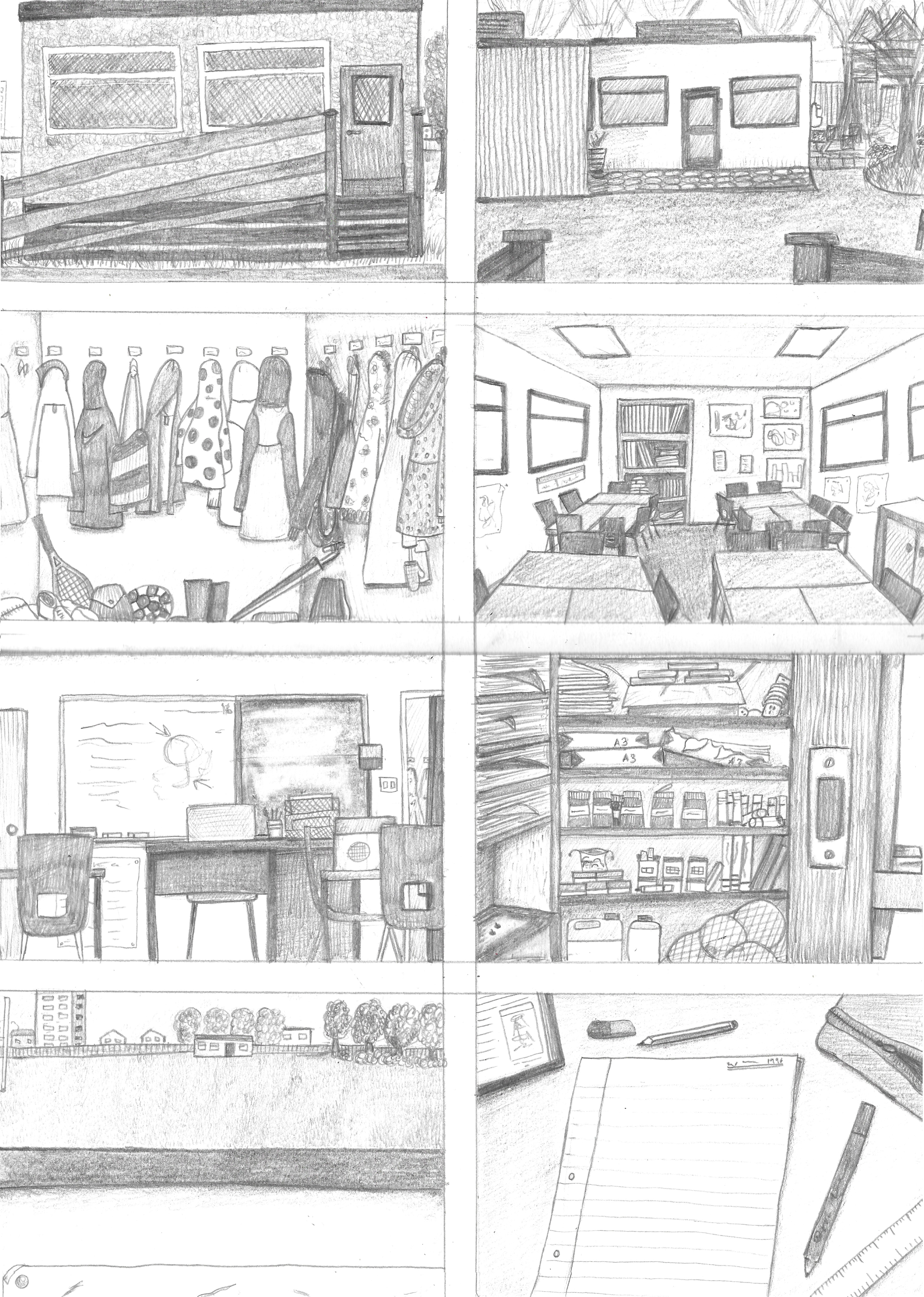Brief
Using the instructions provided, create an 8-panel grid template on a sheet of A3 paper or card.
In the first panel draw a picture of a place you know well and want to visually document. It could be your workplace, a friend’s house, local shop, church or nearby park.
Now visualise the place in your mind and begin to walk around it in your head.
Make a series of pencil drawings of your memories of the place. Try to include as much detail as you can remember. It’s not important that the drawings are technically perfect, but try to include as much information as you can recall. You could also write sounds or snatches of dialogue you might hear as you move around the space.
It was quite a challenge to think of a location that I wanted to visually document, but in the end I chose to test my memory and draw the classroom from my final year at primary school. The year 6 classes (there were just two in those days) each occupied a portacabin located on the edge of very large playing field, which we were very lucky to have as a school. As the school has now almost completely been rebuilt and enlarged, a large portion of the playing field has been lost, it was good to remember what it used to be like.
I generally have avoided drawing buildings and furniture in the past as I struggle with proportions and perspective, which becomes glaringly obvious with these subjects – so the fact that I was forced to attempt to draw them for this exercise was very beneficial.
Although I, unfortunately, was unable to remember the exact details for each picture, I tried my best to provide the overall essence and feeling.
From top left to right:
- Portacabin for my year 6 classroom: the proportions were definitely incorrect for this drawing. The windows/door should have been smaller (there may well have been three windows in reality).
- A section of the main school building viewed from door of portacabin: the perspective was out and, again, the proportion of the windows/door too large. The details on the right of the drawing should have been clearer – it was meant to show the climbing frame and, in the distance, a tarmac area surrounded by fencing and trees/houses.
- The cloakroom, directly in front of the entrance to the portacabin: although I need to improve my drawing skills for depicting clothing, I was quite pleased with this panel.
- View of the classroom: this panel involved plenty of rubbing out! It took a great deal of time to achieve an almost acceptable drawing in which the perspective was uniform for the walls, ceiling, windows, tables, chairs….
- View of the teacher’s desk: the main elements in this panel were the combination of the whiteboard, blackboard and Over Head Projector (which probably would seem like an antique to the current intake of children!). I tried to represent the chalk dust on the black board using an eraser.
- View of stationery cupboard from doorway: this room was generally out of bounds for the children, so I could not remember the exact detail, but every so often I had the privilege of entering the treasure trove of paper, pens and other delights.
- View from window of playing field behind portacabin: I felt this was the least successful of the drawings, which was mostly due to the perspective/proportion and oversimplification of the buildings, etc.
- POV of desk with paper and pens.
Final Thoughts
I have become so used to creating digital images that, although challenging, I am really pleased that this unit has so far required me to return to using pencil/pen and paper – having to work on an A3 scale is not something I regularly do either. Areas I need to work on include: perspective, proportion, tonal range (the drawings all look a bit too similar in terms of greyness), drawing buildings/furniture and straighter lines. Additionally, I did not manage to include any sounds/dialogue in any of the drawings, which is something I should have explored.
Reflection after Tutor Feedback
On returning to this exercise after some time, I was struck by how technically critical of my work I felt at the time of creating the final piece. Of course I still believe that side of things is very important, but having read my tutor’s feedback and discovering examples of work by other artists, I can appreciate a certain quality in the outcome that, although unintentional, is childlike and therefore reflective of the content of the drawings.
Most of the panels are from the point of view of a child and so the oversized buildings and ‘cosy’ classrooms could be said to express a sense of happiness and comfort being in that place, which would be appropriate. The eyeline of the narrator is also suggestive of a child in several of the panels (e.g. views 3, 5, 6 and 7), for example by only just being able to see out of the windows in panel 7, the height of which is depicted in panel 4. In panel 6 the inclusion of the striker plate (I had to look up the name of this) in the door frame suggests that the narrator is most likely that of a child, peering into the stationery cupboard.
Additionally, I thought that the apparent emptiness of the school, even though there are children’s coats and pens/paper on the desk, was quite poignant.
